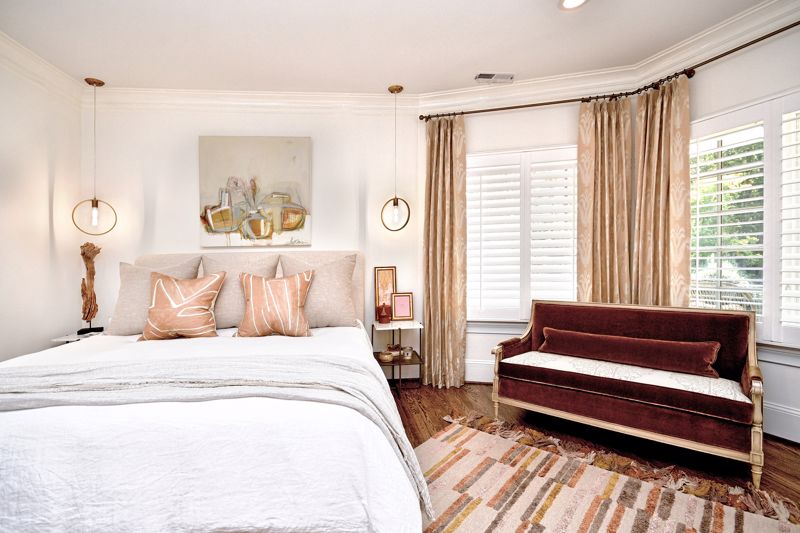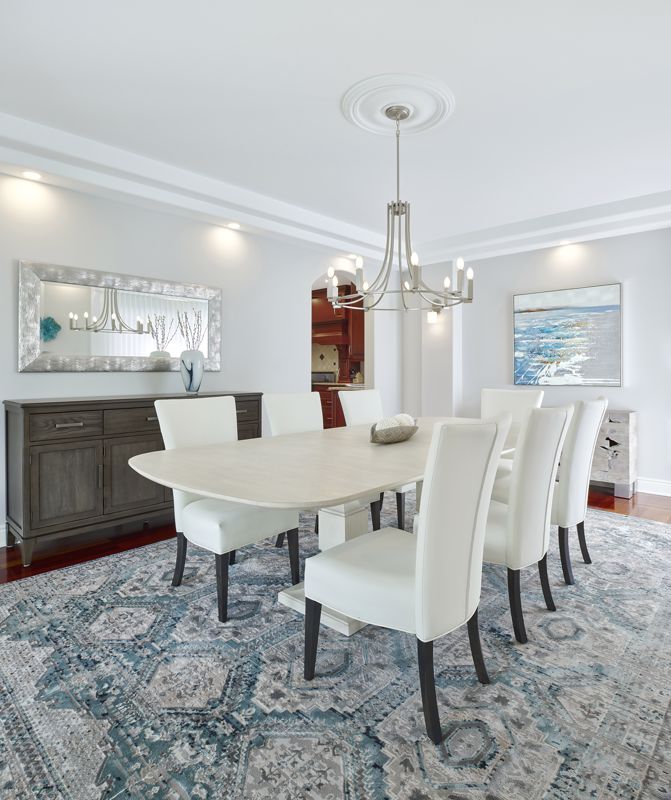A Tale of Two Styles: Crafting a Modern Traditional Living Room Retreat
If you've been binge-watching your favorite HGTV show, you may have noticed a trend: Designers rarely mix more modern styles with traditional decor. Sadly, a traditional decorating style is often left out of the blended aesthetics that have grown super popular over the years, perhaps due to it being a seemingly difficult design style to work with.
But today, we're changing that!
These tips and tricks can help you in your journey to combining modern and traditional design for the perfect living room that's both classy and sleek.
What Exactly Is Modern Traditional Design?
Modern traditional style, sometimes called modern classic style, is a blended interior design and decoration aesthetic that marries both time-honored and contemporary design into one cohesive whole.
Simply put, this design style is all about creating spaces that feel both timeless and current, drawing inspiration from classic design principles while incorporating modern materials, technologies and sensibilities.
Often, modern traditional design borrows the clean lines and simplicity characteristic of many of today's popular styles and combines them with the warmth, familiarity and elegance of a more traditional decorating style. When done right, the result is a perfectly balanced composition that's warm, inviting and familiar.
Using furniture, paint, accent pieces, natural materials and lots of texture, and taking advantage of a home's existing, traditional architectural features, a professional decorator can help you achieve the modern traditional living room look you're aiming for.
Modern vs. Traditional: A Quick Comparison
Modern design tends to sway toward monochromatic color schemes, minimalist furniture and straight lines, and generally places greater importance on function rather than form in terms of furniture.
On the other hand, traditional design is based on popular styles and trends of the 18th and 19th centuries, often showcasing comforting decor and timeless grace. Generally, traditional decor is more detail-oriented, ornate and artisan without being overly fancy.

10 Key Characteristics of a Modern Traditional Living Room: How To Achieve the Look
The keys to achieving a well-balanced final product in your modern traditional living room are plentiful. It's all about borrowing design flavors from each style and mixing until fully incorporated.
Here are just a few of the ways your professional will achieve that:
1. A Blend of Old and New Furniture and Decor
This is the very essence of modern traditional design; it's in the name! The ultimate goal is to seamlessly integrate traditional elements such as ornate woodwork, classic furniture silhouettes and vintage-inspired accessories with modern features like clean lines, minimalist decor and innovative materials.
As an example, envision an old-fashioned chandelier hung over a sleek, contemporary dining table.
2. Balance and Symmetry
Regarding furniture arrangement, balance and symmetry are core principles in modern traditional design. Symmetrical furniture arrangements, architectural details and decorative accents often create a sense of order and harmony in the space.
When arranging furniture, consider creating conversation areas by placing seating to face each other, as a traditional sitting room would have. This will encourage conversation and interaction. In the center of the seating arrangement, use a wooden coffee table or traditional-style ottoman as an anchor.
3. Neutral Color Palette
Neutral colors such as white, beige, gray and taupe tend to dominate the color scheme for this particular design style. That's because these less-offensive colors create a timeless backdrop that allows traditional and modern elements to stand out. Occasionally, bold or muted colors may be used as accents for added visual interest.
4. Clean Lines
While traditional design often features intricate detailing, modern traditional design favors clean lines and simple forms over, say, terrifically twisted, 18th-century four-post bed frame (with curtains to boot!).
Furniture and architectural elements are typically streamlined and free of excessive ornamentation, although ornamentation is still used in other ways for this design style.
5. Traditional Woodwork
From crown molding to pocket doors and big indoor shutters, ensure there's no shortage of standout, artisan woodwork in your home. If you don't have any existing woodwork that fits that description, you or your decorator can source furniture that mimics a sophisticated, traditional design without being too over-the-top.
6. Focus On Comfort
Modern traditional interiors prioritize comfort and livability. Function over form. To accomplish this, it's best to reach for plush seating and cozy textiles — essentially anything that will help create an inviting space for relaxation.
Creating a comforting space also means being aware of clutter and congestion. That said, it's best to leave enough space between furniture pieces so guests can easily transverse the living space without stubbing a toe or shuffling through a narrow opening sideways.

7. Use Statement Lighting
Using traditional-inspired or vintage lighting fixtures as a focal point in the living room is a common design theme for a modern traditional aesthetic. Consider how a striking chandelier or pendant light fixture in the center of the room could stand out against the more contemporary elements of the living room.
8. Use an Area Rug
Certain types of flooring, like hardwood, patterned tile and even natural stone, are well-suited for a modern traditional living room. The problem is that these options can be a bit cold underfoot — especially during the colder months. Luckily, area rugs are a staple in most design styles — modern traditional included.
An area rug with traditional patterns like oriental or Persian designs in contemporary color palettes can tie the space together, giving the best of both a modern and traditional look.
9. Take Advantage of the Fireplace
Fireplaces are as common as they come in traditional homes. So, if your living room has one and you're keen on achieving a modern traditional style, don't tear it out!
Instead, make it a focal point by surrounding it with classic molding or a decorative mantle. Then, pair it with comfortable seating arrangements like plush armchairs or a cozy sectional sofa for those more intimate gatherings.
10. Play With Patterns
Traditional design is all about patterns. So, when modernizing it to fit a modern traditional aesthetic, don't get rid of playful patterns altogether. Instead, incorporate traditional patterns such as damask, paisley or toile in items like upholstery, drapery or area rugs. You can also mix these patterns with more modern geometric prints or stripes to add visual interest and personality to your living room.
Materials, Textures and Details Prevalent in Modern Traditional Design
Now that we know the key design characteristics of modern traditional interiors, let's get a little more granular. Which types of materials are prevalent with this style? Which patterns and textures are best suited for a modern traditional living room?
Natural materials are a big part of this design style, so it's no surprise that a lot of emphasis is placed on using different kinds of woods, stones and metals.
Using the following materials and design elements, your modern traditional living room will start to take shape:
- Wood: We know that wood is a large part of traditional design, but which types? Various finishes such as oak, walnut, cherry or mahogany are commonly used for furniture, flooring and architectural details like moldings and paneling.
- Stone: Natural stone like marble, granite and limestone adds a sense of luxury and elegance to modern traditional interiors, and is commonly used for countertops, flooring, fireplace surrounds and other accents.
- Metal: Brass, copper and iron lend themselves well to the modern traditional aesthetic and are commonly used for elements such as hardware and lighting fixtures, and help provide contrast and richness in the living space.
- Ceramics and porcelain: Traditional ceramics and porcelain are popular for decorative items, tiles and tableware. They add a timeless charm and can feature intricate patterns or designs that add visual interest to your living room.
- Glass: Stained glass windows, decorative glassware and mirrors help add a light elegance to modern traditional interiors. Clear glass is also often used for lighting fixtures.
- Traditional patterns: Fabrics and wallpapers featuring classic patterns such as floral, paisley, toile, damask or plaid can evoke a sense of tradition and nostalgia in modern traditional spaces.
Spruce Up Your Traditional Living Room With Modern Flair
Whether your current living room is all traditional or all modern — or neither — and you're looking to make a change, it's possible with the right expertise and design know-how.
It's out with the old, and in with the new — kind of. To make your traditional living room more modern, or vice versa, you don't have to completely reinvent the wheel: You can swap out a few furniture pieces and change the color scheme to get the look you desire.
Have another style in mind altogether? Take our design quizzes to learn more about which aesthetics speak to you the most.
If you're set on modern traditional, Decorating Den Interiors is here to help you achieve your vision. Find an interior decorator near you to get started.

